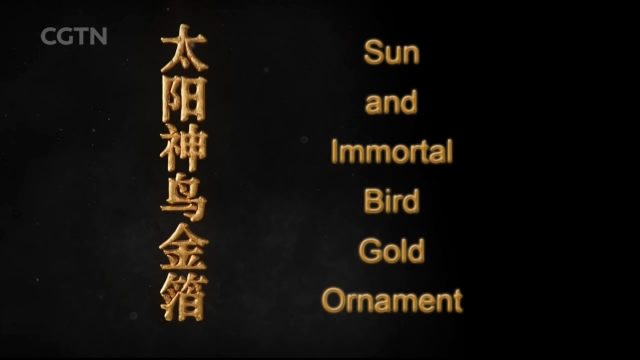
11:17, 16-May-2018
If Treasures Could Talk: What would the Sun and Immortal Bird Gold Ornament reveal?
05:11

We continue our series "If Treasures Could Talk", showcasing some of China's most valuable ancient treasures. Today, we take a look at a Sun and Immortal Bird Gold Ornament from southwestern Sichuan Province. It's been chosen as a symbol of China's cultural heritage.
You have a new message from an ancient treasure. Immortal Bird Sun and Immortal Bird Gold Ornament. A light shining through time. With a flash, the land is lit with gold, and a three thousand year old bird takes wing.
Of all the artifacts found at the Jinsha site in Sichuan, this is the most extraordinary. It's just one fifth of a millimeter thick. And it's 94.2% pure gold.
People say it's emitting the light of life.All five of the world's great ancient civilizations worshipped the sun.
But this depiction of the sun is particularly mysterious. Some say it represents the Sun God, and that the four birds are his emissaries, to the east, west, north and south.
Some say it represents the sun itself, and that the four birds are carrying it across the sky, as described in Chinese legend.
Golden Birds Carrying the Sun.
Some say the birds stand for the four seasons, and that the sun's twelve spiral arms represent the twelve months. Spring, Summer, Autumn, Winter.
As such, four and twelve are references to the passing of time. In this gold disc, the people of ancient Shu used precious gold to create a palm-sized depiction of the universe, as they saw it.
They understood how movements of the sun impacted on the natural world. To recreate the life-giving light of the sun, they chose precious gold.
They also created symbols to represent the gods. Eyes and birds, both represent the sun, and therefore the Shu people's understanding of light and nature.
Earlier Shu culture, as seen at the Sanxingdui site, had featured similar symbols associated with the sun, solar wheels, birds, eyes, sun-shaped Vessel Eye-shaped Vessels Shu people were clearly fascinated by gold, possibly because it shone like the sun.
The "sun and immortal bird gold ornament" was found here, at what experts believe was a sacrificial site. The nine square holes were probably part of the foundations of an altar, where the supporting pillars stood. The burial pits were filled with elephants' tusks, deer's antlers and boars' tusks, along with jade, gold and stone vessels.
Three thousand years ago, this was the site of a grand ceremony – one that probably honoured Nature.
The "sun and immortal bird gold ornament" belonged to a world of mystery and superstition. Today, we're unable to divine its true purpose. Yet its importance is undeniable. In 2005, it was chosen from among 1,600 artifacts, to serve as a symbol of China's National Cultural Heritage. In 20 grams of gold, hammered into a wafer-thin leaf, resides an entire universe.

SITEMAP
Copyright © 2018 CGTN. Beijing ICP prepared NO.16065310-3
Copyright © 2018 CGTN. Beijing ICP prepared NO.16065310-3